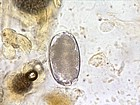| This article is still under construction. |
|
|
The Rhabditids
These are the interface between the parasitic and free-living nematodes. Most spend their whole life-cycle in soil or other inanimate environments, while some are parasitic on plants (such as the potato eel-worm). A few are facultatively parasitic on animals such as Pelodera, which causes dermatitis in dogs and Halicephalobus, which produces ataxia in horses (and other animals) on rare occasions. There is just one regularly parasitic genus in the superfamily: Strongyloides.
NOTE: do not confuse the terms "Strongyloides" and "Strongyloidea"!
Strongyloides Species
Humans and domesticated animals each have their own Strongyloides species (e.g. S. westeri in horses, S. ransomi in pigs). Cross-infection between hosts does not seem to be common, although the dog species (which does not occur in the UK) may be zoonotic.
General Appearance
- Non-bursate
- Superficially, adult parasitic forms look like trichostrongyloids, but:
- only females are parasitic
- they have a very long pharynx
General Life-Cycle
- Egg is small, thin-shelled and contains a larva
- Egg → L1 → L2 → L3 on ground
- L3 → either → L4 → free-living adult (male or female) on ground
- or → L4 → parasitic adult (female only) in small intestine
- Infection is by penetration of skin or buccal mucosa
NOTE: in older animals, larvae accumulate under skin → mammary gland → vertical transmission.
